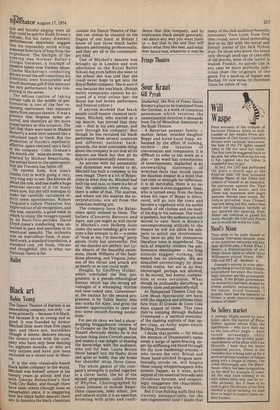Ballet
Black art
Robin Young
The Dance Theatre of Harlem is an astonishing company, not only — or even primarily — because it is black, but because it is so young and so good. It was founded by Arthur Mitchell little more than five years ago, and there are, incredible though it seems, dancers among the twenty-seven with the company who have only been dancing for eighteen months, or who are only sixteen and have just been recruited on a recent tour in Mexico.
It is the only classically-based black ballet company in the world. Mitchell was himself unique in his twenty years as soloist and star 'With George Balanchine's New York City Ballet, and though there have been others (though none so remarkable) since, it is staggering how few black ballet dancers there are. In America the black classicists outside the Dance Theatre of Harlem can almost be counted on the fingers of one hand: in Britain I know of just three black ballet dancers performing professionally, and they are all in the contemporary field.
One of Mitchell's dancers was brought up in London and won admission to the Royal Ballet School, but_even before she went to the school she was told that she could never hope to get into the Royal Ballet company. She is sure it was because she was black. (British ballet companies cannot be accused of a total colour bar: the Royal has had brown performers, and Festival yellow.) If anyone doubted that black people could master classical technique, Mitchell, who started as a tap dancer, has proved that they can — first in his own person, and now through his company. But. though he has recruited his black performers from several countries and different national backgrounds, the most noticeable thing about the company is not that all its dancers are black but that all its style is quintessentially American.
As anyone with his personality and dynamism was bound to do, Mitchell has built a company in his own image. There is a lot of Balanchine in what they do. Mitchell had both tap and jazz, so there is a bit of that. He admires Alvin Ailey, so there is some of that. The sources, and where not the sources the interpretations, are all from the American melting pot.
The company have the Balanchine spirit imbued in them. The ballets (Concerto Barocco and Agon, and one might as well throw in Mitchell's own Holberg Suite under the same heading) give everyone a fair amount to do — a series of "look at me, I'm dancing" party pieces, lively but uneventful. Not all the dancers are perfect: but Lydia Abarca of the beautiful extensions, Derek Williams of the fastidious phrasing, and Virginia Johnson of the thrust and attack are as nearly so as one could wish.
Dougla, by Geoffrey Holder, which concluded the first programme, is a pseudo-ethnological fantasy which has the strong advantages of a whumping rhythm and near-naked men. Caravansaiai, the exotica for the second programme, is by Talley Beatty who also works for Ailey, and gives the dancers opportunities to open out into some smooth-flowing modernism.
For pas de deux we had a showstopping braggadoccio version of Le Corsaire on the first night. Paul Russell obviously thinks he is the hottest thing gince Cornish pasties, and makes a real delight of sharing the knowledge with the audience, who yell for him. Laura Brown threw herself into the flashy dives and spins so boldly that she broke her shoulder strap three times.
The whole gamut of the company's strengths is pulled together in a clever ballet, the hit of the second programme, called Forces of Rhythm. Choreographed by Louis Johnson to include Balanchine classicism, Ailey ethnic, jive and cabaret-styles, it is an assertion bouncing with pride and confi
dence that this company, and by implication black people generally, can dance any way you want them to — but that in the end they will dance what they like best, and what they dance best, whatever it may be.


































 Previous page
Previous page